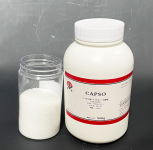Chinese VersionChina Suppliers > Hubei new DE sheng material science and technology co., LTD. > Introduction to Biological Buffer CAPSO
- Search Product
-
-
- Region :China/Hubei
- Tel : +86-18971041571
- Fax :
- Email :vickyzhao@whdschem.com
- URL :
- Add :Guanggu United Science and Technology City C8, Ezhou City, Hubei Province
- Details for Introduction to Biological Buffer CAPSO
-
Introduction to Biological Buffer CAPSO
Category : Other Chemicals/Others

CAS NO : 73463-39-5 EC NO : MF : C9H19NO4S MW : 237.3165 Specification : White Powder Packing : 500g/bottle Product description : Biobuffers play an undeniable role in fields such as biochemical analysis and in vitro diagnosis, and as one of the types of buffers, CAPSO is gradually being applied in a wide range of fields. As a zwitterionic buffering agent, it has a white powder appearance and good solubility in water. Compared with other insoluble buffering agents, CAPSO is more convenient to use. Below, we will introduce it specifically to you. Preparation of CAPSO buffer solution 1. Prepare the required proportion of CAPSO sodium salt powder, distilled water (dH2O), stirring rod, and large beaker for the experiment. 2. Pour CAPSO sodium salt and corresponding proportion of distilled water into a beaker, stir with a stirring rod until CAPSO sodium salt powder is dissolved. 3. Next, it is necessary to adjust to the required pH value, and then pour distilled water (dH2O) to the required volume. 4. Filter, disinfect, and sterilize to obtain the CAPSO finished solution. Application of CAPSO buffer solution 1. It is often used in enzyme catalyzed reactions and the preparation of some detection reagents, or in immunoblotting and precipitation experiments. 2. It can be prepared as a lysis solution for extracting membrane proteins, and CAPSO serves as a buffer to prevent significant changes in pH, maintain ion strength within a reasonable range, and prevent protein from binding with other ions to form insoluble products. 3. It can provide a good storage condition for various experimental solutions, which is conducive to stable and effective storage and avoids adverse reactions. 4. It can be used in medical diagnostic kits and has significant clinical significance for the generation and treatment of diseases such as liver disease and myocarditis. Precautions for using CAPSO buffer solution 1. Due to the powdered nature of the produced CAPSO, it is important to avoid moisture during use and store it tightly at room temperature. After use, it should be immediately sealed. If it is a prepared solution, it needs to be stored at a low temperature of 4 degrees Celsius. 2. In order to achieve good buffering effect of CAPSO, it is recommended to use it as it is, to avoid long-term shelving, which may lead to deterioration and affect the experimental detection process. 3. During the experiment, it is necessary to take proper precautions, wear protective gear, and avoid direct contact with the skin. If accidentally touching the skin, rinse it thoroughly with flowing water. Desheng is a direct supplier of biological buffer solutions. It develops, produces, and sells its own products, ensuring purity and controlling both the process and raw materials. Even if problems arise, it can provide immediate solutions and provide customers with one-stop services. If you have any interested parties, please feel free to call for more information! Uses : Biological buffer Synonyms : 3-(Cyclohexylamino)-2-hydroxy-1-propanesulfonic acid;CAPSO;3-[CYCLOHEXYLAMINO]-2-HYDROXY-1-PROPANESULFONIC ACID;3-(CYCLOHEXYLAMINO)-2-HYDROXY-1-PROPANESULPHONIC ACID;3-(CYCLOHEXYLAMINO)-2-HYDROXYL-PROPANESULFONIC ACID;3-CYCLOHEXYLAMINO-2-HYDROXY-PROPANE-1-SULFONIC ACID;3-(CYCLOHEXYLAMINO)-2-HYDROXYPROPANESULFONIC ACID;CAPSO Free Acid ;CAPSO FREE ACID SIGMAULTRA;3-(Cyclohexylamino)-2-hydroxy-1-proparesulfonic acid;(2S)-3-(cyclohexylammonio)-2-hydroxypropane-1-sulfonate;(2R)-3-(cyclohexylammonio)-2-hydroxypropane-1-sulfonate;3-(Cyclohexylamino)-2-hydroxy-1-propanesuIfonic acid; Molecular Structure : 
- more>>Other Products
-
- • Biological buffer 3- [N, N-di (hydroxyethyl) amino] -2-hydroxypropanesulfonic acid DIPSO
- • Luminol Sodium Salt
- • 4-Aminophthalhydrazide
- • acridinium ester DMAE-NHS
- • acridinium ester NSP-DMAE-NHS
- • Acridine hydrochloride NSP-SA
- • Acridine hydrochloride NSP-SA-NHS
- • NSP-SA-ADH
- • acridinium ester ME-DMAE-NHS TOOS; 3-(N-Ethyl-3-Methylanilino)-2-Hydroxypropanesulfonic Acid Sodium Salt
- • TOPS; Sodium 3-(N-Ethyl-3-Methylanilino)Propanesulfonate; N-Ethyl-N-Sulfopropyl-M-Toluidine Sodium Salt
- • ADOS Sodium 3-(Ethyl(3-Methoxyphenyl)Amino)-2-Hydroxypropane-1-Sulfonate Dihydrate
- • ADPS N-Ethyl-N-(3-Sulfopropyl)-3-Methoxyaniline Sodium Salt
- • ALPS N-Ethyl-N-(3-Sulfopropyl)Aniline Sodium Salt; Sodium 3-(Ethyl(Phenyl)Amino)Propane-1-Sulfonate; Sodium
- • DAOS; Sodium 3-((3,5-Dimethoxyphenyl)(Ethyl)Amino)-2-Hydroxypropane-1-Sulfonate
- • HDAOS; N-(2-Hydroxy-3-Sulfopropyl)-3,5-Dimethoxyaniline Sodium Salt
- • MADB N,N-Bis(4-Sulfobutyl)-3,5-Dimethylaniline Disodium Salt
- • MAOS N-Ethyl-N-(2-Hydroxy-3-Sulfopropyl)-3,5-Dimethylaniline Sodium Salt Monohydrate
- • DAB 3,3',4,4'-Biphenyltetramine Tetrahydrochloride